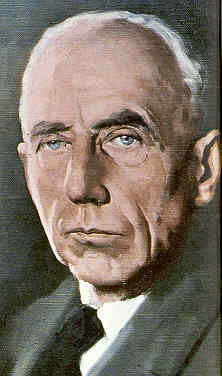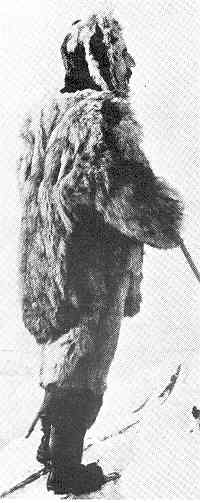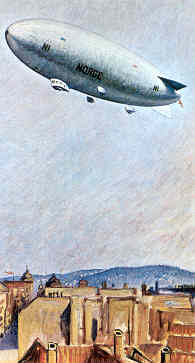 Roald Amundsen was a great
man, but in real life also a little child. His intention was not to
discover the world, but the world had to discover Roald Amundsen. With
this inner self force he discovered the North-West Passage with the Gj?
and he was the first man who set food on the Geographical South Pole. At
the same time his rival, the British explorer Scott, died in the attempt.
Roald Amundsen was a great
man, but in real life also a little child. His intention was not to
discover the world, but the world had to discover Roald Amundsen. With
this inner self force he discovered the North-West Passage with the Gj?
and he was the first man who set food on the Geographical South Pole. At
the same time his rival, the British explorer Scott, died in the attempt.
Heading for exploring the North Pole he surprised the world by doing this, making exploring the South Pole as a race as if it was a holiday skiing tour, leaving the dramatic events for the British. The public opinion reacted against him and when the British heard from the letter he left for Scott he couldn't do any good anymore. Admitting the defeat was one but have to bring the writing evidence with him (Scott) enrage the British. Then there was Kristine Elisabeth Bennet, a beautiful Norwegian lady married with a prominent Englishman. She found her romantic passion, which she was missing in her marriage, with Amundsen, and this also didn't contribute to Amundsen's popularity.
Fridtjof Nansen, who gave up his own resolved expedition to the South Pole, what had to be the climax of his life, and had disclaimed his rights on the FRAM for Amundsen's expedition to the North Pole, remembered Amundsen to his duty. He had to prove to Nansen, the Norwegian nation and to the rest of the world that his tour to the South Pole had nothing to do with an unsporting double-cross and that it was part of one great plan.
 Amundsen made the promise
and ordered to built a new ship called MAUD for the latter part of the
expedition; follow the North-East passage to Bering Strait and then, after
entering the pack ice, to drift with the polar current to Spitsbergen and
Greenland.
Amundsen made the promise
and ordered to built a new ship called MAUD for the latter part of the
expedition; follow the North-East passage to Bering Strait and then, after
entering the pack ice, to drift with the polar current to Spitsbergen and
Greenland.
After drifting for three years with little progress, his mind was more and more with his beloved Kristine. He had no inner feeling but a duty to this expedition. He thought Nansen's theory was right, but one has to start at the right place. He became a frustrated man. In the world outside almost everyday new inventions and discovery's were made, and he was just waiting there, outside from everything. He wanted to work at his future, and to his opinion this future was in the air. In winter 1921 the Nansen method was taken as read. He left the ship, accompanied by two adopted Eskimo children, and went back to civilization.
Now he was planning a new Pole expedition by airplane. For this purpose he purchased two planes and christened them Kristine and Elisabeth, after his beloved mistress in London. Unfortunately the expedition became a fiasco. Elisabeth ended up in a lagoon, while Kristine crashed during take off.
Again everyone turned against him and the Norwegian people were ashamed for his incapacity. It was a bad knock for the growing Norwegian patriotism. As a journalist said "it's like the man who so often tells he will committing suicide and at the end seeing no other way out than to hang himself". Amundsen was bankrupt and offended deep in his soul. He couldn't take care anymore for the two adopted Inuit girls and send them back to Siberia by saying, well, it was just an experiment. To escape from all the conflicts he went to New York to search for new funds for his North Pole project. At the age of 53 he was deep depressed and desperate.
In New York the Prince Charming felled right out of the air. The American aviator Lincoln Ellsworth, with a lot of family money, was prepared to finance his dream, a flight across the North Pole. Amundsen was beloved again and the newspapers were screaming out the new expedition plans. In the spring of 1925 they started their preparations on Spitsbergen and they bought two Dornier seaplanes, the N24 en N25. During their attempt Amundsen in the N25 landed at an open spot of water to calculate their position. The N24 with Ellsworth landed not far away from him. But the open spot was much to soon frozen again and Amundsen could narrowly safe his N25. The N24 was useless being already damaged during the take off at Spitsbergen. The only way home was by air so they had to make a runway. This was a difficult job as the ice was constantly moving and more than once the N25 had to be saved for cracking. After 24 days on the ice they managed to take off with the N25, leaving all the heavy stuff behind.
Back in Spitsbergen both America and Norway glorified the heroism and a Royal welcome was organized. The New York Times headlined:

Amundsen didn't understand all the commotion. The expedition didn't even reached his target and they only saved their lives. But then he forgot that people love the stories of disaster. The world didn't want to see flags on maps, but adventure, heroism and hardships.
In 1926 Amundsen and Ellsworth bought a huge zeppelin in Italy, being the superb transportation for crossing the Pole. The Italian president Mussolini wanted to give the airship for free, but than it has to fly under Italian flag. For Amundsen this was out of the question and he christened the zeppelin NORGE while Ellsworth paid the bill. Designer and pilot was the Italian colonel Umberto Nobile. This man seems to bee the ideal captain, knowing all the whims off the hulk.
 From the beginning the men
didn't match with each other, Nobile being ambitious and patriotically and
trying to get most of the honour. Amundsen made clear that Nobile was just
the driver. They fly over the Pole in 71 hour. By means of a trick with a
supposed broken radio, Nobile managed to inform the world as first, which
made Amundsen furious, and off course he highlighted only the Italian
contribution, leaving Amundsen as an observer.
From the beginning the men
didn't match with each other, Nobile being ambitious and patriotically and
trying to get most of the honour. Amundsen made clear that Nobile was just
the driver. They fly over the Pole in 71 hour. By means of a trick with a
supposed broken radio, Nobile managed to inform the world as first, which
made Amundsen furious, and off course he highlighted only the Italian
contribution, leaving Amundsen as an observer.
Nobile was promoted to General and started a new expedition with a new zeppelin, the ITALIA. Unfortunately he crashed somewhere in the north of Spitsbergen. Several rescue operations were undertaken to find the Italian team. Also Amundsen was offering Mussolini to organise a salvage, but this was firmly turn down by Mussolini, remembering the conflicts between Nobile and Amundsen. Mussolini preferred the heroic dead of Nobile instead of an inglorious salvation. Nevertheless Amundsen made a decision for a private action to rescue his arch-enemy. In June 1928 he flew by seaplane to effect the rescue of Nobile.
Roald Amundsen was never seen again and was probably crashed in the sea off the Norwegian coast.
Nobile was rescued by a fearless Swedish pilot (and discharged by the Italian Government).